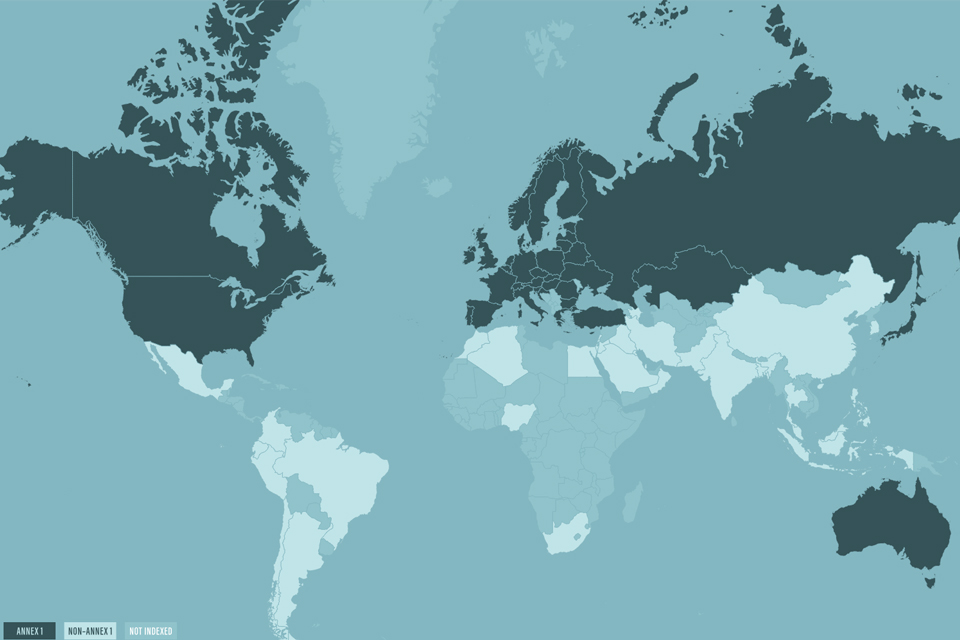Military spending and emissions are rising but reporting is getting worse.

Our 2025 analysis of the military emissions data that countries report to the UNFCCC reveals that reporting is getting worse, with the top three military spenders the US, China and Russia either not submitting data or submitting incomplete data. Grace Alexander explores how, at a time of growing military spending, the expanding military emissions gap is undermining climate accounting and ambition.
Introduction
For global emission stocktakes to accurately reflect the true state of the world’s greenhouse gas (GHG) output, all sources must be counted. Yet military emissions remain exempt from UN Framework Convention on Climate Change (UNFCCC) reporting, leaving a significant gap in the data that shapes international climate policies. Reporting military emissions to the UNFCCC is not mandatory and standards remain low. While some nations voluntarily disclose their data, reporting is often patchy and inconsistent, revealing how little scrutiny this high-emitting sector faces in global climate accounting.
Militaries are responsible for an estimated 5.5% of global emissions. However, this is only an estimate due to the lack of official data reported to the UNFCCC. Military emissions are likely to grow given recent increases in military expenditure, with SIPRI finding a 9.4% increase in military spending in 2024 compared to 2023, the steepest year-on-year rise since at least the end of the Cold War. UNEP’s 2025 Emissions Gap Report confirms that the world is still on course to overshoot the Paris Agreement’s 2°C and 1.5°C pathways, accelerating dangerous warming.
Our Military Emissions Gap dataset tracks and analyses the gap between what the top 60 military spenders report to the UNFCCC, and what we expect them to emit. In the UNFCCC’s 2025 update, which covers emissions from 2023, many countries still fail to report or disaggregate their military emissions, revealing a persistent gap in global reporting.

The state of military emissions reporting in 2025
The 2025 Military Emissions Gap dataset covers the most recent updates to UNFCCC emissions reporting. These are from 2023 as national inventory reports are released two years after the year the emissions occurred. Annex I countries are obligated to submit their national GHG inventory annually. Meanwhile Non-Annex I countries — those countries that were viewed as developing at the time of the Kyoto Protocol in 1991 — are not required to submit their national GHG emissions inventory annually but should submit a report every two years.
Reporting has not changed dramatically in comparison to previous years. Countries either don’t report military emissions data, the data is patchy, or it’s not clearly disaggregated from civilian emission sources. Given the estimated scale of military emissions — sectors such as shipping are estimated to account for 3% of global emissions — this gap in reporting is significant.
The three countries with the largest military expenditures, the US, Russia and China, either do not report their emissions, have not provided up-to-date data, or do not clearly disaggregate their military emissions. With the US and China responsible for more than half of global military expenditure in 2024, the absence of reliable emissions data from these top spenders leaves a critical gap in global climate accounting.
Major reporting gap: the US
Despite being the world’s largest military spender, spending over $916 billion on its military in 2023, the US has not submitted any emissions inventory report to the UNFCCC for the 2025 submission of 2023 data. As a member of the UNFCCC, the US was required to submit an annual national inventory report by the 15th of April. However, given the Trump administration’s decision to withdraw the US from the Paris Agreement, it is unlikely that a report will be forthcoming. The lack of transparent emissions data undermines global emissions totals and, given the high military expenditure of the US, its contribution to global military emissions is significant.
| Country name | United States |
|---|---|
| Stationary emissions (as reported under 1A5a) MtCO2e | No Report Submitted |
| Mobile emissions (as reported under 1A5b) MtCO2e | No Report Submitted |
| Gap in emissions reporting | No comparison possible. |
| Data accessibility score | Very poor - no data reported through the UNFCCC. |
| Military expenditure (2023), US$ millions | 916014.7 |
| Global military expenditure rank | 1 |
| % of GDP | 3.3 |
| Latest national inventory report (NIR) | No data or report submitted for 2025. |
| Latest in country reporting | Department of Defense GHG inventory, 2024. |
| Military climate strategy | Previously published in 2022, however, under the current administration climate-related efforts within the Department of Defense have been significantly scaled back. |
Major reporting gap: Russia
The Russian Federation is an Annex I country and the world’s third largest military spender. It spent $100 billion on its military in 2023 and has submitted emissions data for some military activities. However, this data is not clearly separated from civilian emission sources, obscuring the scale of Russia’s military carbon footprint. Meanwhile, key categories, such as mobile military emissions, including from military aviation, remain unreported. The absence of key data limits transparency, leaving the true climate impact of Russia’s military largely unknown, aside from some civil society efforts to assess it.
Moreover, Russia’s reported military emissions show a sharp dip from 40 MtCO2 in 2020 to 21 MtCO2 in 2021, and to 15 MtCO2 in 2022 (2024 data release), before rising again to 42 MtCO2 in 2023 (2025 data release). Military fuel use emissions were unlikely to have fallen in 2022, given that this was the year Russia launched its full-scale invasion of Ukraine. The reported drop may instead reflect declines in other, non-military sources that have not been clearly separated from military emissions, or inclusion of these emissions in another category, highlighting the need for more clearly disaggregated military emissions reporting. Alternatively, it could point to selective or incomplete reporting. Although Russia’s 2024 change in its emissions reporting methodology mainly concerns land-use, land-use change and the forestry sector, the shift raises broader questions about transparency, selective reporting and how accurately emissions and military emissions are captured.
| Country name | Russian Federation |
|---|---|
| Stationary emissions (as reported under 1A5a) MtCO2e | 42.201 |
| Mobile emissions (as reported under 1A5b) MtCO2e | "Not occurring". "Included elsewhere". "Not available". |
| Gap in emissions reporting | No comparison possible. |
| Data accessibility score | Poor - disaggregated data not reported through the UNFCCC. |
| Military expenditure (2023), US$ millions | 109,203.6 |
| Global military expenditure rank | 3 |
| % of GDP | 5.4 |
| Latest national inventory report (NIR) | Latest data from 2023. Military emissions are included in "other emissions" under 1A5, together with other government agencies. Emissions data for 2.G.2.a (Military Applications) reported as "not occurring". There appear to be no other entries, e.g. under international bunker fuel, and multilateral operations reported as "not occurring". |
| Latest in country reporting | - |
| Military climate strategy | - |
Major reporting gap: China
At $300 billion China ranked second in global military expenditure in 2023. As a Non-Annex I country China faces no formal obligation to report its emissions to the UNFCCC, including its military-related emissions. While China has voluntarily submitted an emissions inventory, the latest data only covers 2021’s emissions, with no military emissions reported, leaving a significant blind spot. This lack of transparency and reporting requirements for one of the world’s largest military budgets creates a significant gap in understanding the country’s potential contribution to global military emissions. China’s emissions reporting gap highlights the challenge of assessing the climate impact of major militaries outside Annex I reporting requirements.
| Country name | China |
|---|---|
| Total emissions (as reported under 1A5) MtCO2e | "Not occurring". |
| Gap in emissions reporting | No comparison possible. |
| Data accessibility score | Very poor - no data reported through UNFCCC. |
| Military expenditure (2023), US$ millions | 296,821.4 |
| Global military expenditure rank | 2 |
| % of GDP | 1.63 |
| Latest GHG emission reporting to UNFCCC | Data from 2021 and the latest Biennial Update Report. No 1A5 data provided and stated as "not occurring". |
| In-country reporting | - |
| Military Climate Strategy | - |
Data for decision-making
This year’s update, which is based on 2023’s data, suggests that the military emissions gap is widening, with no overall improvement in reporting or transparency. On top of this, large data gaps from the three biggest military spenders reveal a huge blind spot in military emissions data. Opaque reporting of military emissions not only obscures their true scale but also undermines efforts to understand and tackle the climate crisis. Without urgent improvements in emissions transparency and reporting, the full climate impact of militaries will remain hidden, leaving policymakers and the public in the dark as the planet faces escalating climate risks.
Grace Alexander is CEOBS’ military and climate researcher. To explore this year’s Military Emissions Gap dataset in full, visit: www.militaryemissions.org. If you find our work useful, please consider a donation so that we can continue it.





